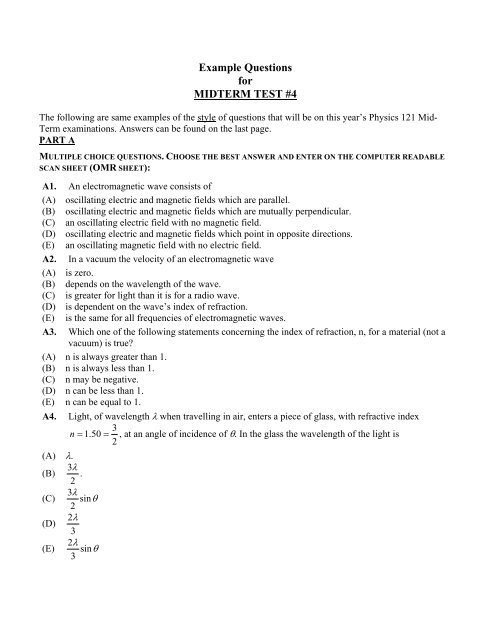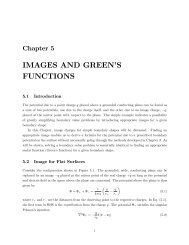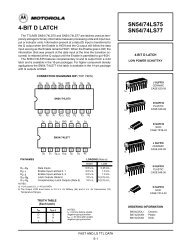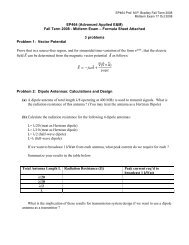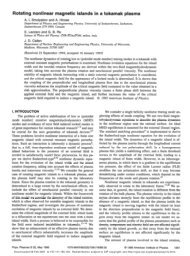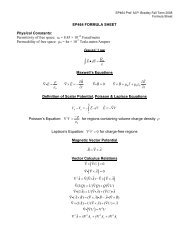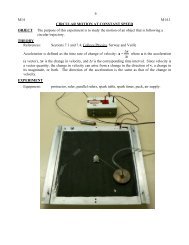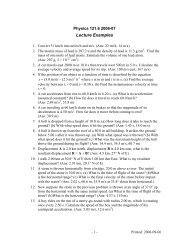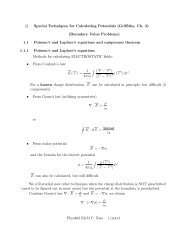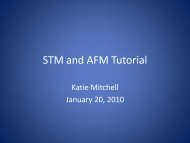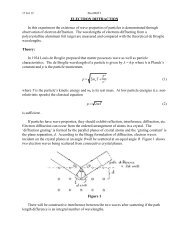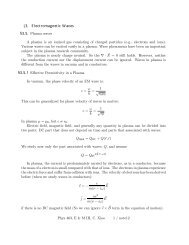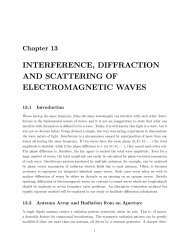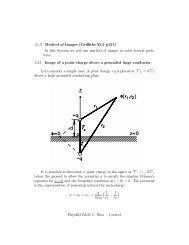Example Questions for MIDTERM TEST #4 - Department of Physics ...
Example Questions for MIDTERM TEST #4 - Department of Physics ...
Example Questions for MIDTERM TEST #4 - Department of Physics ...
You also want an ePaper? Increase the reach of your titles
YUMPU automatically turns print PDFs into web optimized ePapers that Google loves.
<strong>Example</strong> <strong>Questions</strong><strong>for</strong><strong>MIDTERM</strong> <strong>TEST</strong> <strong>#4</strong>The following are same examples <strong>of</strong> the style <strong>of</strong> questions that will be on this year’s <strong>Physics</strong> 121 Mid-Term examinations. Answers can be found on the last page.PART AMULTIPLE CHOICE QUESTIONS. CHOOSE THE BEST ANSWER AND ENTER ON THE COMPUTER READABLESCAN SHEET (OMR SHEET):A1. An electromagnetic wave consists <strong>of</strong>(A) oscillating electric and magnetic fields which are parallel.(B) oscillating electric and magnetic fields which are mutually perpendicular.(C) an oscillating electric field with no magnetic field.(D) oscillating electric and magnetic fields which point in opposite directions.(E) an oscillating magnetic field with no electric field.A2. In a vacuum the velocity <strong>of</strong> an electromagnetic wave(A) is zero.(B) depends on the wavelength <strong>of</strong> the wave.(C) is greater <strong>for</strong> light than it is <strong>for</strong> a radio wave.(D) is dependent on the wave’s index <strong>of</strong> refraction.(E) is the same <strong>for</strong> all frequencies <strong>of</strong> electromagnetic waves.A3. Which one <strong>of</strong> the following statements concerning the index <strong>of</strong> refraction, n, <strong>for</strong> a material (not avacuum) is true?(A) n is always greater than 1.(B) n is always less than 1.(C) n may be negative.(D) n can be less than 1.(E) n can be equal to 1.A4. Light, <strong>of</strong> wavelength λ when travelling in air, enters a piece <strong>of</strong> glass, with refractive index3n = 1 .50 = , at an angle <strong>of</strong> incidence <strong>of</strong> θ. In the glass the wavelength <strong>of</strong> the light is2(A) λ.(B)3λ.2(C)3λ sinθ2(D)2λ3(E)2λ sinθ3
A10. Alyssa has a far point <strong>of</strong> 5 m. Which one <strong>of</strong> the following statements about Alyssa’s vision iscorrect?(A) She has normal vision.(B) She is myopic (nearsighted) and requires diverging lenses to correct her vision.(C) She is myopic (nearsighted) and requires converging lenses to correct her vision.(D) She is hyperopic (farsighted) and requires diverging lenses to correct her vision.(E) She is hyperopic (farsighted) and requires converging lenses to correct her vision.A11. The figure shows the interferenceScreenpattern observed on a screen in adouble-slit experiment using light <strong>of</strong>Bright fringeswavelength 600 nm. Which fringeDark fringeson the screen is 1200 nm furtheraway from one <strong>of</strong> the slits than fromDSlitsthe other slit?E(A) AA(B) B(C) C(D) DB(E) ECentral Bright FringeCA12. Consider a ray <strong>of</strong> light in water thatstrikes a water-air interface at an angle <strong>of</strong> incidence less than the critical angle. Which one <strong>of</strong> thefollowing statements is correct?(A) The ray <strong>of</strong> light partially reflects into the water and partially transmits into the air; the angle <strong>of</strong>refraction is greater than the angle <strong>of</strong> incidence.(B) The ray <strong>of</strong> light partially reflects into the water and partially transmits into the air; the angle <strong>of</strong>refraction is less than the angle <strong>of</strong> incidence.(C) The ray <strong>of</strong> light totally transmits into the air; the angle <strong>of</strong> refraction is greater than the angle <strong>of</strong>incidence.(D) The ray <strong>of</strong> light totally transmits into the air; the angle <strong>of</strong> refraction is less than the angle <strong>of</strong>incidence.(E) The ray <strong>of</strong> light totally reflects into the water.A13. The dependence <strong>of</strong> the refractive index <strong>of</strong> a material on the wavelength <strong>of</strong> the incident light isknown as(A) refraction.(B) reflection.(C) polarization.(D) transmission.(E) dispersion.
A14. A single diverging lens can <strong>for</strong>m only(A) enlarged and inverted images.(B) reduced and inverted images.(C) reduced and virtual images.(D) enlarged and real images.(E) enlarged and virtual images.A15. In a scene from a movie, a nearsighted character removes his glasses and uses them to focus thenearly-parallel rays from the sun to start a fire. What is physically wrong with this scene?(A) Parallel rays cannot be focused.(B) The glasses have diverging lenses and cannot be used to focus parallel rays.(C) The glasses have converging lenses and cannot be used to focus parallel rays.(D) Sunlight cannot be used to start a fire.(E) A fire can only be started if the image <strong>of</strong> the sun is virtual.A16. A person wears eyeglasses with a power <strong>of</strong> –4.00 diopters to correct his eyesight so that he can seeclearly at distances between 25.0 cm and infinity. Which one <strong>of</strong> the following statements is correct?(A) He is myopic and his uncorrected far point is at infinity.(B) He is myopic and his uncorrected near point is less than 25.0 cm.(C) He is hyperopic and his uncorrected near point is greater that 25.0 cm.(D) He is hyperopic and his uncorrected far point is not at infinity.(E) He is hyperopic and his uncorrected near point is less than 25.0 cmA17. When viewing the moon through a simple, two-lens astronomical telescope we see craters thatappear 10 times wider than they appear with the unaided eye. If the eyepiece has a focal length d,what must the focal length <strong>of</strong> the objective lens be?(A) 10d(B) 100d(C) 10 d(D) d / 10(E) d / 10
PART BIN EACH OF THE PART B QUESTIONS ON THE FOLLOWING PAGES, GIVE THE COMPLETE SOLUTION ANDENTER THE FINAL ANSWER IN THE BOX PROVIDED.THE ANSWERS MUST CONTAIN THE APPROPRIATE NUMBER OF SIGNIFICANT FIGURES AND THE UNITSMUST BE GIVEN.SHOW YOUR WORK – NO CREDIT WILL BE GIVEN FOR ANSWERS ONLY. EQUATIONS NOT PROVIDED ONTHE FORMULAE SHEET MUST BE DERIVED.B1. An object is placed on the principal axis <strong>of</strong> a converging lens with focal length 204 mm. The imageproduced is inverted and is exactly twice as large as the object.(a)Find an expression <strong>for</strong> the image distance, d , in terms <strong>of</strong> the object distance, dio, <strong>for</strong> thissituation.(b) Calculate the object distance, d o.(c) Calculate the image distance d i.(d) On the figure below sketch a ray diagram <strong>for</strong> this situation. Show at least two rays from theobject to the image.FFB2. A cello string vibrates in its fundamental mode with a frequency <strong>of</strong> 220.0 Hz (the note A). Thevibrating segment <strong>of</strong> the string has length 70.0 cm and has mass 1.20 g.(a)(b)(c)Find the tension in the string.rdWhen this string is vibrating in its 3 harmonic, what is the wavelength <strong>of</strong> the waves in thestring?A finger is pressed on the string to reduce the length <strong>of</strong> the vibrating segment <strong>of</strong> the string toa length x. The tension in the string remains the same. When this is done the fundamentalfrequency is 261.63 Hz (the note C). Find the length x.
B3. Two converging lenses, each having a focal length <strong>of</strong> 12.0 cm, are placed 60.0 cm apart. An objectis placed 19.0 cm to the left <strong>of</strong> the first lens.19.0 cm60.0 cmobjectLens 1 Lens 2(a) Determine the location <strong>of</strong> the final image relative to lens 2.(b) Determine the orientation and magnification <strong>of</strong> the finalimage relative to the original object.Orientation:Upright / InvertedMagnification:
Answers:A1: BA2: EA3: AA4: DA5: EA6: AA7: AA8: CA9: DA10: BA11: CA12: AA13: EA14: CA15: BA16: BA17: AB1: (a) d i = 2d o (b) 0.306 m (c) 0.618 mB2: (a) 163 N (b) 0.467 m (c) 0.589 mB3: (a) 21.3 cm to right <strong>of</strong> lens 2 (b) upright, 1.33


